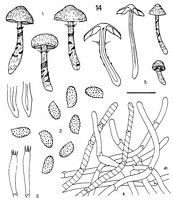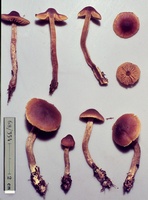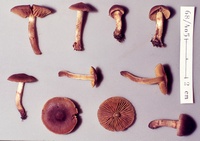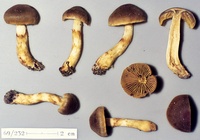|
 Dermocybe leptospermorum Dermocybe leptospermorum
BiostatusPresent in region - Indigenous. Endemic
Images (click to enlarge)
Caption: Dermocybe leptospermarum: 1. carpophores. -2. spores. - 3. basidia. - 4. pileipellis. - 5. carpophores. | 
Caption: ZT68-354
Owner: E. Horak: © Creative Commons Attribution-Noncommercial 3.0 New Zealand | 
Caption: ZT68-405
Owner: E. Horak: © Creative Commons Attribution-Noncommercial 3.0 New Zealand | 
Caption: ZT69-232 , Holotype
Owner: E. Horak: © Creative Commons Attribution-Noncommercial 3.0 New Zealand | |
Article: Horak, E. (1988) [1987]. New species of Dermocybe (Agaricales) from New Zealand. Sydowia 40: 81-112.
Description: Pileus -40 mm, hemispherical or broadly umbonate-expanded to campanulate; brown to yellow-brown, often with distinct olive tinge, towards margin paler or yellow; dry, but subviscid in moist condition, glabrous, innately fibrillose or subsquamulose, hygrophanous, margin striate when fresh, occasionally with yellow-brown fibrillose veil remnants at margin. - Lamellae 14-20, 3-5, emarginate, sometimes slightly decurrent with short tooth, -5 mm wide; mustard yellow, turning yellow-brown with rust brown tinge; edges concolorous, even or dentate. - Stipe -50 x -7 mm, cylindrical (rarely subclavate or subfusoid), central, single or cespitose; yellow below yellow-brown fibrillose cortina with several inconspicuous or persistent appressed zones of yellow-brown veil remnants; dry, longitudinally fibrillose, hollow, occasionally with yellow basal tomentum which turns pink or pale cinnabar red in dried specimens. - Context yellow-brown, dark brown in base of stipe. - Odour raphanoid. - Taste bitter to raphanoid. - Chemical reactions on pileus: KOH - red-brown.
Spore print rust brown. - Spores 6-7.5(-8) x 3.5-4(-4.5) µm, ovoid, verrucose. - Basidia 20-35 x 5-7 µm, 4-spored often with red-brown plasmatic pigment. - Cheilocystidia absent.
Pileipellis a cutis or trichoderm of cylindrical hyphae (4-10 µm diam.), terminal cells cylindrical or fusoid-conical, membranes slightly gelatinized, with encrusting and plasmatic red-brown pigment, ± insoluble in KOH. - Clamp connections present.
Habitat: On soil under Leptospermum scoparium. - New Zealand.
Notes: All records of D. leptospermarum are reported from localities dominated by Leptospermum spp. and an ectomycorrhizal relationship with L. scoparium and/or L. ericoides can be assumed.
In this Dermocybe bright mustard yellow lamellae contrast with the rather dark brown colours of the pileus which occasionally shows distinct olive shades over its disk.
It is noteworthy that KOH (applied to the pileocutis) causes a colour change from yellow-brown to a distinct red-brown. The actual pigment, however, does not dissolve in KOH (3%). Chemical analysis of the pigments has demonstrated that endocrin and flavomannin (and related derivates) predominate in carpophores of D. leptospermarum. Other anthraquinones (emodin, dermolutein, etc.) frequently isolated in related New Zealand taxa are absent in D. leptospermarum (KELLER & al., 1988).
|